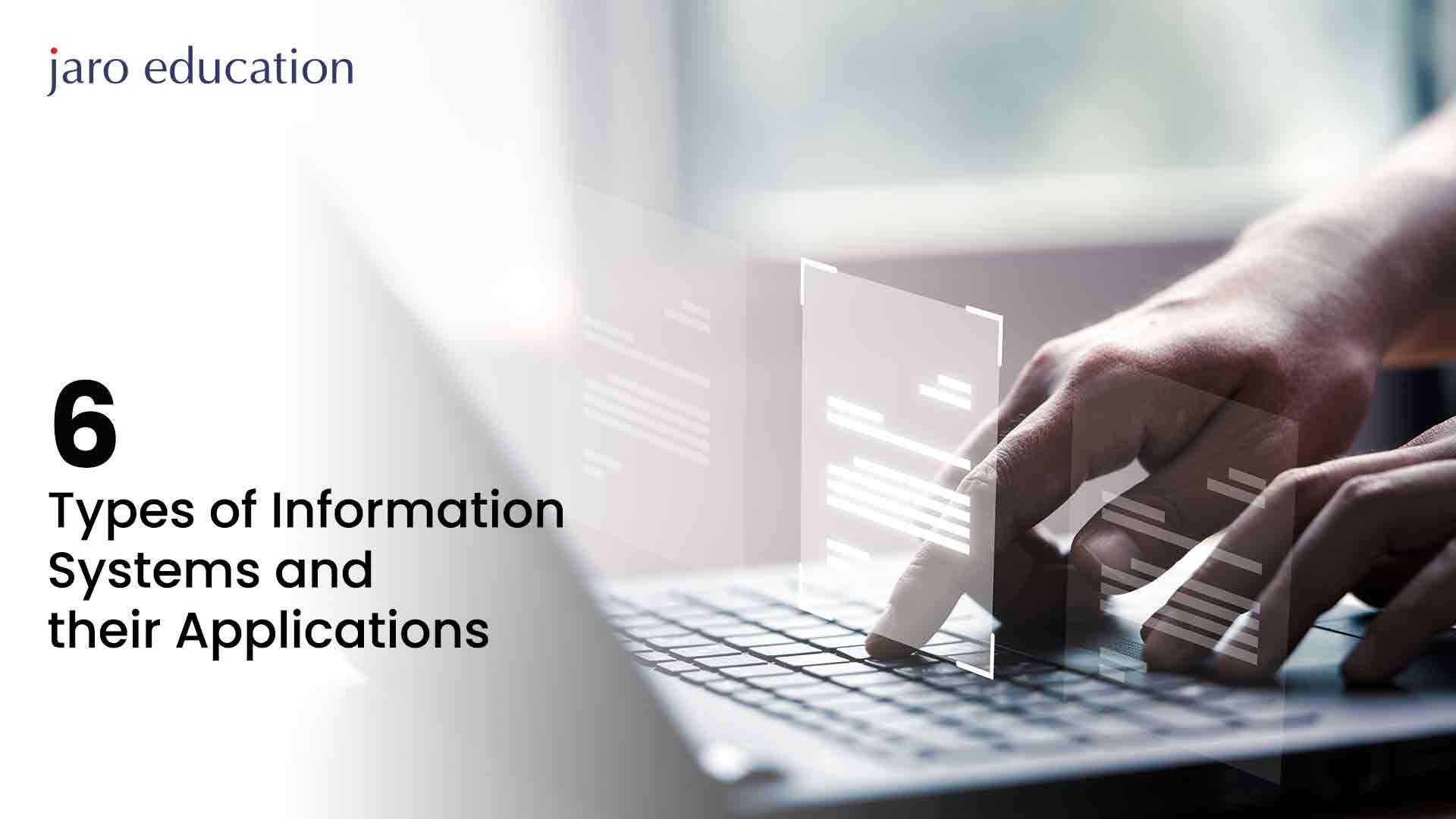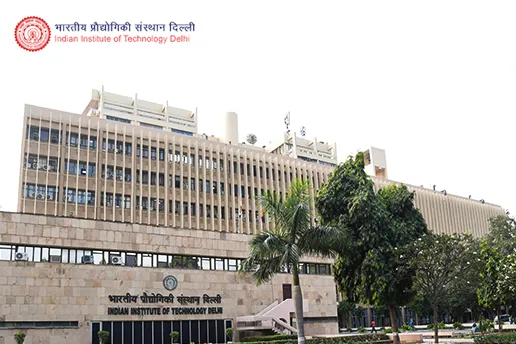
- jaro education
- 27, January 2024
- 11:00 am
The field of information systems is a broad umbrella term that covers features such as database management, communication systems, multiple connections, various devices, the internet, organization, data collection and storage, and other information-related applications that are commonly used in the workplace.
Numerous companies have adopted information systems and created applications that comply with the evolving technology as a result of changes in information technology and its systems. In order to deal with consumers and suppliers and further develop an internal healthy connection, the business world requires many sorts of information systems. These information systems not only contribute to the overall management of an organization but also assist the company in facilitating marketing strategies. There are mainly 6 types of information systems, and in this blog, we have explained these information systems types in detail.
Key Factors Influencing Information Systems
We have spotlighted some major key factors that impact the influence of Information Systems:
1. Design a Strategy
Table of Contents
Without a strategy and a well-built plan, no business can grow and flourish smoothly. On the basis of strategy, information plans are developed to capitalize on available opportunities and combat risks in the outside world. For that, computers can be of great help. They are not just memory boxes, they allow the user to analyze data fast and accurately. Thus, computerized information systems aid managers in a correct and swift manner which uses the information in smart strategic decisions, making it a critical but also a prime operation.
2. High-Quality
In a business or industry, quality should never be compromised; therefore, information systems are one such technology that helps improve the quality of the data. Various tools are used to enhance the quality of data. Check sheets, histograms, fishbone diagrams, etc are a few of the major tools used that rewardingly impact businesses and primarily help it multiply to larger extents.
3. Budget and Expenses
For using the unique features of information technology one needs a computer setup. Even though buying a computer system can be expensive, it is a one-time expenditure compared to the human workforce, where you have to pay monthly checks to your workers and employees. Therefore, comparatively, a computer is cheaper and accomplishes the task accurately in less time.
A Brief Overview Of Information Systems
Let us familiarise you with 6 types of Information Systems and their applications through this blog below:
1. Knowledge Management System
The first among the 6 different types of Information Systems is the Knowledge Management System. Knowledge is an immense power to a company or an organization. A Knowledge Management System (KMS) mainly gathers information to create a knowledge base for users. This process largely helps in developing connections between various departments. Knowledge Management Systems are used to organize a company’s paperwork, FAQs, and other pertinent data. Even though the KMS makes all documented firm information freely available to its employees and consumers, the data is varyingly distributed. The System of Knowledge management is further classified into three types: Explicit, Tacit and Implicit.
Explicit
This is a type of knowledge that can be easily coded and shared. This form of knowledge is simple to communicate and easily comprehended by others. Employee handbooks, Standard operating procedures, and HR rules are examples of explicit knowledge.
Tacit
Tacit knowledge is comparatively difficult to understand from explicit knowledge. It consists of those qualities of an employee’s expertise which are difficult to share with others. Tacit knowledge comprises customer service expertise, design abilities, and so forth.
Implicit
Similar to tacit knowledge is Implicit knowledge, except it is more easily codifiable that is it can easily be written in computer language. It is information that is ingrained in the processes of the organization but is currently unarticulated. It is indigenous knowledge that can be taught and conveyed but has yet to be properly recorded.
Apart from the significant advantages of Knowledge Management Systems, it has major drawbacks and challenges in the industry. Few of those are not maintaining privacy and security of your data, knowledge sharing becomes crucial due to lack of trust and reliability and the need for advanced technology becomes expensive and economically difficult to afford.

*eternalsunshineoftheismind.wordpress.com
2. Decision Support System
A Decision Support System(DSS) is a web-based database that helps the company in problem-solving and decision-making fields. The database stores the essential company’s data and analyses it carefully in order to assist the firm in taking appropriate action. The user can access the conveniently provided information and tools used for data modification. One example of such a system is medical diagnosis provided by hospitals and infirmaries. DSS assists in visualizing data and making it easier to interpret, which improves management’s capacity to make successful judgments quickly and easily. Apart from that, it usually converts the data into comprehensible charts and tables that can be easily analyzed by managers and users.
3. Transaction Process System
Transaction Process System(TPS) helps a business with its day-to-day operations smoothly without any haste. TPS executes this task by gathering the data extensively and making necessary modifications to it. After the data is prepared, it is retrieved back to the user’s system. The striking characteristic of this system is that it increases the overall performance and growth of business transactions. Even though it is a complicated task, once the user gets familiar with it, the task becomes painless and manageable. Because of its global availability, regardless of location or language, an effective TPS enables a firm to create amicable and dependable connections with other businesses and customers.
4. Executive Support System
Similar to the Management Information System (MIS), the Executive Support System (ESS) performs decision-making at the expert management level. The top-level managers and owners use this system to assist themselves in problem-solving and decision-making to maintain the company’s workflow. This system provides effective communication, enhanced processing skills and excellent display alternatives to the managers and displays the information through organized flowcharts, static reports and graphs.
5. Office Automation System
Office Automation Systems allow data to be transferred from one system to another without the need for manual labor or human involvement. The OAS conducts office-related matters and facilitates official activities at all levels of the organization. Official activities are classified into two categories: management and clerical. Office Automation System comprises of the following applications:
Along with sending messages, you can attach audio notes, images, videos, and important documents.
Voice-mail
You can record and store voice messages in your system’s memory and access it whenever required.
Word processing
You can create documents such as memoranda, reports, letters, and anything else that is electronically printed in word processing. Using word processing commands, the resulting text may be copied, altered, and saved, as well as checked for headers and footers, spelling and grammar checks, and the number of words and lines.
6. Management Information System
The management information system assists managers by automating several operations that were performed by human forces. A Management Information System (MIS) investigates people, technology, organizations, and their interrelationships and can help you find the best information for a company’s management, which can be pertinent to developing investment plans. These systems emphasize service through technology, therefore data analysis and project management are their major functions. MIS also evaluates and assesses business performance, makes hard-core business choices, develops a business strategy, and establishes workflow. Besides that, it thoroughly analyses roles and responsibilities and gives feedback into the manager’s workflow.
Major Industry Applications of MIS
Information technology is playing a major role in the business industry and making every piece of work smooth and commendable. Here are a few Information System applications of this fast-growing technology:
1. Decision-Making Becomes Easy
One of the major Information System applications is ensuring an easy decision-making process. Coming to a decision is an intricate and challenging procedure in a business setup. You never know whether you are making the right decision and whether your decision will be successful or not. However, information systems enable you to analyze the intrinsic charts and reports pre-prepared for a wise and thoughtful decision. In certain ways, the information system has aided the company’s stakeholders in making judgements smartly and quickly. Since information technology offers instantaneous information, companies can make confident judgments swiftly.
2. Information/Data Storage
Information Technology stores the data and paramount information of any corporation accurately in the system. It allows immediate access to data when necessary and the space for storage should be cost-effective with abundance, allowing the organization to be more profitable. A strong information storage system also assists businesses in keeping track of important operations and storing the company’s precious assets. Companies may track difficulties and obstacles in their operations and gain an idea of how to fix them by properly keeping data and business information.
3. Rolling Out New Products and Services
Customers’ ever-increasing desires are what propel a business. Information systems help in keeping track of new business procedures that may enter the market. Any company that wants to be successful in the business sector should make better business judgments and introduce new items and services into the market based on client requirements and desires. Information systems help businesses build and launch new products and services into the market.
4. Improving Employee Behaviour and Attitude
Information systems are used to improve interpersonal communications between the company and employees. Companies can encourage their employees by providing them with a more accessible and trustworthy information system. Due to this tactic, employees feel valued because they are included in the decision-making process. The spirits of staff members rise as a result of the sense of empowerment, and they become more engaged in the organisation.
What are the Challenges Associated with Information Systems?
1. Maintaining Privacy and Security
Privacy and Security are the major issues in the information systems of the business sector. As organizations focus more on digital platforms sensitive data should be protected from cyber-attacks and compliance with privacy requirements should be maintained. Another major problem that lines up is the perpetually shifting technological world, with the need to respond to quick changes while still managing old systems.
2. Data Management
Managing and integrating information from several sources is a commendable task of data management. It is also necessary to ensure that the data is not only comprehensive and correct but also reliable and dependable. An ongoing effort must be applied and the data should be presented in a uniform manner through seamlessly active integrations.
3. Technical Challenges
Delivering data without compromising its efficiency and maintaining an equilibrium of increasing load extends to issues of effective performance. The exchange of data and compatibility amidst different technologies is essential in the IT environment and creates a responsive and cohesive technical approach.
4. Human Factors
For using the information systems humans need to be well-trained and adopt skills for the integral success of the proposed system. One should use data and technology in a responsible manner, keeping in mind certain ethical considerations for maintaining a positive organisational reputation.
5. Global Nature Of Business
Subsequently, challenges related to the global nature of business wherein cultural differences, international connections and the need to adapt to diverse environments become a prodigy.
Upcoming Trends in Information Systems
1. Artificial Intelligence and Machine Learning
In this new generation of advancement, AI has been a popular topic globally. Through the further integration of Information technology, thorough decision-making and data analysis, there will be vigorous growth in the field of Machine learning and Artificial Intelligence.
2. Cybersecurity Advancements
Cybersecurity can be reinforced through the branches of information technology and its progress. As technology and global linkage are increasing rapidly, the rate of cyber-scams and threats is also growing. For this reason, information technology is further analyzed and amalgamated with other technologies to create a secure and protected cyber world.
3. Augmented Reality(AR) And Virtual Reality(VR)
Industries such as gaming, healthcare, remote collaboration and education will be boosted drastically due to the fast-changing world of Information technology.

*www.gartner.com
4. 5G Technology Adaptations
A faster and more reliable 5G network will be introduced, enabling new possibilities for real-time applications and fostering the Internet Of Things (IoT) devices.
5. Genomics
A groundbreaking upturn in the field of medicine and healthcare will be implemented. A process in which your DNA and genes will be studied carefully and analyzed to predict the possible healthcare problems in the child before birth itself. This process of digitally analyzing DNA and genes is termed as Genomics.
6. Robotic Process Automation(RPA)
The adaptation and advancement of RPA reduce the bugs and mistakes caused by human error in business proficiency. This increases the efficiency and growth of the business.
7. Data Privacy and Ethics
A large number of measures have been taken to improve data privacy and ethical considerations so that the Internet can be safer and trustworthy.
8. Blockchain Technologies
Blockchain doesn’t only limit itself to Bitcoin and cryptocurrencies but also implements sectors like medicine, finance, supply chain management etc.
9. Quantum Computing
Efforts have been made for the prominent development of Quantum Computing through widespread adoption, which may bring a revolutionary change in the world.
Conclusion
The world of Information Technology is vast, so you will have to explore some enthralling options to break through the internet and shake the roots of this industry. If you are an owner of a business, you must follow the trends of this peculiar world of the internet ruled by information technology and wait for your product to take the storm through the internet. You must start at early and follow an innumerable pace of potential growth, leading to success and prosperity.
On the other hand, if you want to gain proficiency in Information Technology, there are many reputable Information System courses online. One such institute is Manipal University Jaipur, which offers a well-recognised and dynamically mapped Online MCA Degree Program. It follows a synchronous, well-structured program offering online courses taught by well-versed professors in an integrated manner. You will not only apprehend the trends designed in this course but your ability to bring innovation will be polished simultaneously. Jaro Education gives you a hands-free platform to enroll in this program effortlessly. Register today!









